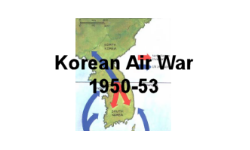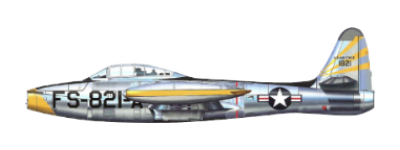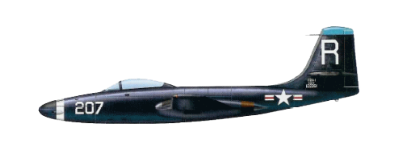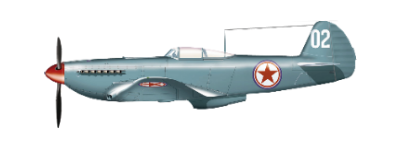 Republic F-84 'Thunderjet' Republic F-84 'Thunderjet'
The Republic F-84 Thunderjet was an American turbojet fighter-bomber aircraft. Originating as a 1944 United States Army Air Forces (USAAF) proposal for a 'day fighter', the F-84 flew in 1946. Although it entered service in 1947, the Thunderjet was plagued by so many structural and engine problems that a 1948 U.S. Air Force review declared it unable to execute any aspect of its intended mission and considered canceling the program. The aircraft was not considered fully operational until the 1949 F-84D model and the design matured only with the definitive F-84G introduced in 1951. The Thunderjet became the USAF's primary strike aircraft during the Korean War, flying 86,408 missions and destroying 60% of all ground targets in the war as well as eight Soviet-built MiG-15 fighters. Over half of the 7,524 F-84s produced served with NATO nations. The USAF Strategic Air Command had F-84 Thunderjets in service from 1948 through 1957.
Back to Top
Development
On 11 September 1944, the USAAF released General Operational Requirements for a day fighter with a top speed of 600 mph (521 kn, 966 km/h), combat radius of 705 miles (612 nmi, 1,135 km), and armament of either six 0.50 in (12.7 mm) or four 0.60 in (15.2 mm) machine guns. In addition, the new aircraft had to use the General Electric TG-180 axial turbojet which entered production as the Allison J35. On 11 November 1944, Republic received an order for three prototypes of the new XP-84 Model AP-23. Since the design promised superior performance to the Lockheed-built P-80 'Shooting Star' and Republic had extensive experience in building single-seat fighters, no competition was held for the contract. The name 'Thunderjet' was chosen to continue the Republic Aviation tradition started with the P-47 'Thunderbolt' while emphasizing the new method of propulsion. In 1944, Republic Aviation's chief designer, Alexander Kartveli, began working on a turbojet-powered replacement for the P-47. The initial attempts to redesign the P-47 to accommodate a jet engine proved futile due to the large cross-section of the early centrifugal compressor turbojets. Instead, Kartveli and his team designed a new aircraft with a streamlined fuselage largely occupied by an axial compressor turbojet engine and fuel stored in rather thick unswept wings.
Meanwhile, wind tunnel testing by the National Advisory Committee for Aeronautics revealed longitudinal instability and stabilizer skin buckling at high speeds. The weight of the aircraft, a great concern given the low thrust of early turbojets, was growing so quickly that the USAAF had to set a gross weight limit of 13,400 lb (6,080 kg). The results of this preliminary testing were incorporated into the third prototype, designated XP-84A, which was also fitted with a more powerful J35-GE-15 engine with 4,000 lbf (17.79 kN) of thrust. The F-84E, however, corrected most of the Thunderjet's shortcomings. On 4 January 1945, even before the aircraft took to the air, the USAAF expanded its order to 25 service test YP-84As and 75 production P-84Bs (later modified to 15 YP-84A and 85 P-84B). The Thunderjet became the Army Air Forces' second jet fighter to enter large-scale production, and it first flew flight in February 1946. Early F-84s had several problems, including weak wing spars, excessive weight and shortages of engines and spare parts. Back to Top
In Service
A 1948 review of the entire F-84 program discovered that none of the F-84B or F-84C aircraft could be considered operational or capable of executing any aspect of their intended mission. The program was saved from cancellation because the F-84D, whose production was well underway, had satisfactorily addressed the major faults. A fly-off against the F-80 revealed that while the Shooting Star had a shorter takeoff roll, better low altitude climb rate and superior maneuverability, the F-84 could carry a greater bomb load, was faster, had better high altitude performance and greater range. The first effective and fully capable Thunderjet was the F-84E model which entered service in 1949. The aircraft featured the J35-A-17 engine, further wing reinforcement, a 12 in (305 mm) fuselage extension in front of the wings and 3 in (76 mm) extension aft of the wings to enlarge the cockpit and the avionics bay, an A-1C gunsight with APG-30 radar, and provision for an additional pair of 230 gal (870 L) fuel tanks to be carried on underwing pylons. The latter increased the combat radius from 850 to 1,000 miles (740 to 870 nmi; 1,370 to 1,610 km). One improvement to the original F-84 design was rocket racks that folded flush with the wing after the 5-inch HVAR rockets were fired, which reduced drag over the older fixed mounting racks. This innovation was adopted by other U.S. jet fighter-bombers. The definitive straight-wing F-84 was the F-84G which entered service in 1951. The aircraft introduced a refueling boom receptacle in the left wing, autopilot, Instrument Landing System, J35-A-29 engine with 5,560 lbf (24.73 kN) of thrust, a distinctive framed canopy (also retrofitted to earlier types), and the ability to carry a single Mark 7 nuclear bomb. The Thunderjet's takeoff performance left much to be desired. In hot Korean summers with a full combat load, the aircraft routinely required 10,000 ft (3,000 m) of runway for takeoff even with the help of RATO bottles (two or four of these were carried, each producing 1,000 lbf (4.4 kN) of thrust for 14 seconds). Pilots nicknamed the Thunderjet 'The Lead Sled'. It was also called 'The Iron Crowbar', 'a hole sucking air', 'The Hog' ("The Groundhog"), and 'The World's Fastest Tricycle', 'Ground Loving Whore' as a testament to its long takeoff rolls. However, once airborne, the F-84 was a pilots aircraft that responded well to its controls. Back to Top
Korea
The Thunderjet had a distinguished record during the Korean War. Although the F-84B and F-84C could not be deployed because their J35 engines had a service life of only 40 hours, the F-84D and F-84E entered combat with 27th Fighter Escort Group on 7 December 1950. The aircraft were initially tasked with escorting the B-29 'Superfortress' bombers. The first Thunderjet air-to-air victory was scored on 21 January 1951 at the cost of two F-84s. The F-84 was a generation behind the swept-wing MiG-15 and outmatched, especially when the MiGs were flown by more-experienced pilots, and the MiG counter-air mission was soon given to the F-86 'Sabre'. Like its famous predecessor, the P-47, the F-84 switched to the low-level interdiction role at which it excelled. The F-84 flew a total of 86,408 missions, dropping 55,586 tons (50,427 metric tons) of bombs and 6,129 tons (5,560 metric tons) of napalm. The USAF claimed F-84s were responsible for 60% of all ground targets destroyed in the war. During the war, the F-84 became the first USAF fighter to utilize aerial refueling. In aerial combat, F-84 pilots were credited with eight MiG-15 kills against a Soviet-claimed loss of 64 aircraft. The total losses were 335 F-84D, E and G models. Back to Top

F-84F 'Thunderstreak'
A final note on the unusual production of the straight winged F-84 series and the swept wing F-84F:- In 1949, a swept wing version of the F-84 was created with the hope of bringing performance to the level of the F-86. The last production F-84E was fitted with a swept tail, a new wing with 38.5 degrees of leading edge sweep and 3.5 degrees of anhedral, and a J35-A-25 engine producing 5,300 pound-force (23.58 kN) of thrust. The aircraft was designated XF-96A. It flew on 3 June 1950 with Otto P. Haas at the controls. Although the airplane was capable of 602 knots (693 mph, 1,115 km/h), the performance gain over the F-84E was considered minor. Nonetheless, it was ordered into production in July of 1950 as the F-84F Thunderstreak. The F-84 designation was retained because the fighter was expected to be a low-cost improvement of the straight-wing Thunderjet with over 55 percent commonality in tooling. The straight-wing F-84A to F-84E and F-84G models were called the 'Thunderjet'. The F-84F 'Thunderstreak' and RF-84F Thunderflash were a different airplane with swept wings. The XF-84H Thunderscreech (not its official name) was an experimental turboprop version of the F-84F. Production delays on the F-84F resulted in another order of the straight-wing version, which was the definative F-84G.
By the mid-1960s, the F-84/F-84F was replaced by the F-100 Super Sabre and the RF-84F by the RF-101 Voodoo in USAF units, being relegated to duty in the Air National Guard. The last RF-84F Thunderflash retired from the ANG in 1971. Three Hellenic Air Force RF-84Fs that were retired in 1991 were the last operational F-84s. Some 7,524 F-84's of all types were built. Back to Top
|
 Republic F-84 Thunderjet 3 View
Republic F-84 Thunderjet 3 View
 Republic F-84 Thunderjet Cutaway
Republic F-84 Thunderjet Cutaway
|
Specifications: (F-84G)
Country of Origin: USA
Crew: 1
Length: 38 ft 1 in (11.60 m)
Wingspan: 36 ft 5 in (11.10 m)
Height: 12 ft 7 in (3.84 m)
Weight: Empty: 11,470 lb (5,200 kg) Loaded: 18,080 lb (8,200 kg)
Powerplant: 1 × Allison J35-A-29 turbojet, 5,560 lbf (24.7 kN)
Performance
Maximum speed: 622 mph (540 kn, 1,000 km/h,Mach .81)
Cruise speed: 475 mph (413 kn, 770 km/h)
Combat radius: 1,000 mi (870 nmi, 1,600 km)
Service ceiling: 40,500 ft (12,350 m)
Rate of climb: 3,765 ft/min (19.1 m/s)
Thrust/weight: 0.31 lbf/lb
Armament
Guns: 6 × .50 in (12.7 mm) M3 Browning machine guns, 300 rpg
Bombs/Rockets: Up to 4,450 lb (2,020 kg) of rockets and bombs, including 1 × Mark 7 nuclear bomb
|
|




 Korean War
Korean War P-80 Shooting Star
P-80 Shooting Star F-84 Thunderjet
F-84 Thunderjet F-86 Sabre
F-86 Sabre AD1 Skyraider
AD1 Skyraider F2H Banshee
F2H Banshee F9F Panther
F9F Panther Seafury
Seafury Meteor
Meteor Mig-15
Mig-15 Yak-9
Yak-9 IL-10 Shturmovik
IL-10 Shturmovik



 Republic F-84 'Thunderjet'
Republic F-84 'Thunderjet'

